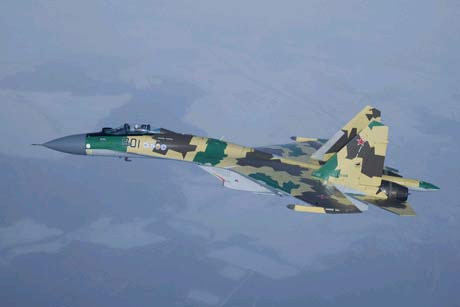|
Moscow: Russia's ministry of defence and the Sukhoi Joint Stock Company on Tuesday signed a 80 billion ruble ($2.5 billion) contract for the supply of 64 Sukhoi-series fighters to the Russian Air Force, the Russian prime minister, Vladimir Putin said. Under the contract signed at the MAKS-2009 air show at Zhukovsky outside Moscow, the Russian Air Force will be supplied with 48 Su-35S, 12 Su-27SM and four Su-30M2 fighter jets. 
According to prime minister Vladimir Putin, the contract "sets a record in modern Russian history." He said aircraft deliveries would be completed by 2015. Putin also said the Russian government would provide an additional $100 million to Sukhoi's capital from the federal budget. The head of Vnesheconombank (VEB), Vladimir Dmitriyev, said the national development bank would grant Sukhoi a 3.5 billion-ruble ($109 million) loan to start production of Su-35 jets. The Su-35 is a 4++ generation aircraft employing technologies of the fifth generation and, according to Sukhoi, it is a far superior aircraft as compared to all other 4th generation fighters now under development worldwide. Sukhoi claims that the fifth generation technologies employed in the aircraft will ensure that the Su-35 will dominate the world market, outperforming other proposed multi-role fighters. The Su-35 fighter is powered by thrust vectoring engines and displays high manoeuvrability as well as the capability to engage several targets simultaneously. It can carry up to eight metric tons of combat payload on 12 external mounts. Russian Air Force commander, Col. Gen. Alexander Zelin, had said earlier that up to three air regiments would be equipped with Su-35 fighters in the future. Russia also hopes to export at least 160 Su-35 fighters to several countries including India, Malaysia and Algeria. Su-35
The fighter has an improved airframe which dramatically increases its service life to 6,000 hours or 30 years of operation. The time before the first test and recondition and the in- between repairs period has been increased to 1,500 hours, or 10 years of operation. Unlike the Indian Su-30MKI it features no canard fins. It is an electronically controlled aircraft without mechanical cabling. The improved radar stealth reduces the reflectance of the Su-35 in the X radio waveband and in the angle range of ±60°. The new 117S engines are substantially modified AL-31F production engines employing fifth-generation technologies providing increased thrust. The engines use a new fan, new high and low pressure turbines and a new digital control system. Compared to existing AL-31F engines the 117S will display 2 to 2.7 times higher performance. Avionics
The distinctive feature of Su-35 is the employment of a new suite of onboard instruments. Its core is the information management system (IMS), which integrates functional, logical, informational and software subsystems into a single complex that ensures the interaction between the crew and equipment. The IMS includes two central digital computers, commutation and information devices and an indication system built on the ''all-glass cockpit'' concept. The core of the Su-35 cockpit instrumentation suite are two full-colour multi-function liquid crystal displays of MFI type, a multi-function panel with a built-in display processor, a wide angle collimatory display on the windshield and a control and indication panel. Televised information will also be received from onboard TV sensors which will be displayed alongside numeric, alphabetic and symbolic information. The onboard systems and armament in the new cockpit of Su-35 are controlled by buttons and switches on the aircraft control joystick and engine control levers as well as by a button array on multi-function displays realizing the HOTAS concept. The core of the Su-35 armament is a new radar control system with a phased antenna array (Irbis-E). It features unique capabilities in terms of the target detection range. This is an X-waveband multi-role radar with a passive phased antenna array (PAA) mounted on a two-step hydraulic drive unit (in azimuth and roll). While the antenna device scans by an electronically controlled beam in azimuth and angle of elevation in sectors not smaller than 60° the two-step electro-hydraulic drive unit additionally turns the antenna by mechanical means to 60° in azimuth and 120° in roll. Through electronic control and an additional mechanical turn of the antenna, the maximum deflection angle of the beam grows to 120°. The Irbis-E radar detects and tracks up to 30 air targets and is capable of engaging up to eight targets. It also detects, chooses and tracks up to four ground targets with various resolutions at a range of up to 400 km. According to Sukhoi, with increased effective range, improved anti-jamming capability, Irbis is comparable to the best foreign counterparts, outperforming most of the US and West-European radars with passive and active PAA. Armament
In addition to the armaments carried by the Su-30MK series the Su-35 is armed with new types of air-to-air and air-to-surface guided missiles, including long-range types. The maximum ordnance load of the Su-35 is 8,000 kg. This is placed on 12 weapon stations.
|